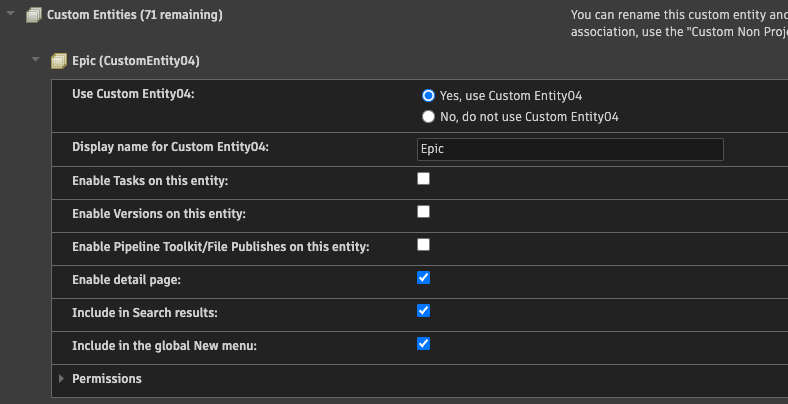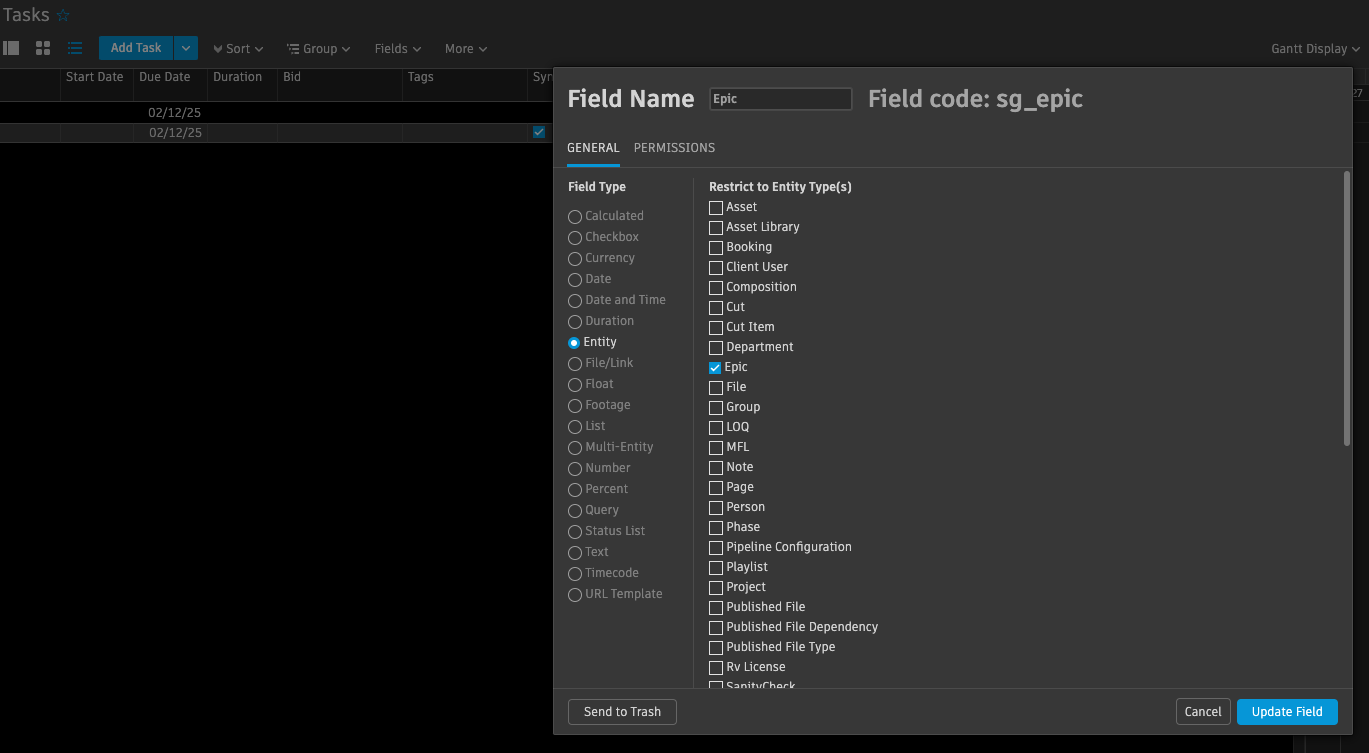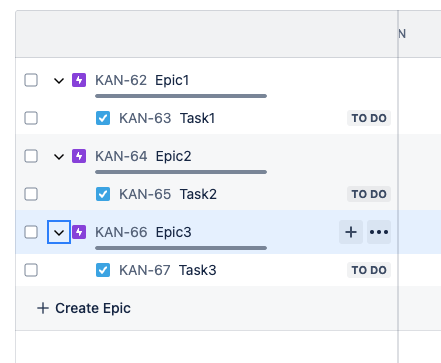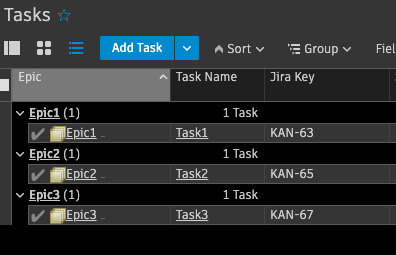Generic Syncer
Description
In order to make the Jira Bridge customization easier, we’re introducing a new syncer/handler. It offers the following changes:
Uses the
settings.pyfile to define the entities and fields we want to synchronizeAdds support for initiating the sync from Jira, not only from Flow Production Tracking
Introduces a new hook functionality to override the behavior of some methods
Configuration
At this point, we are assuming that the Jira Bridge has been correctly configured by following the main configuration process. The next section describes only the steps required to set up and configure this new handler.
Jira Configuration
For each Issue Type we want to sync in Jira, we need to make sure that the following Jira fields exist and are available in Boards:
Field Name |
Type |
Description |
|---|---|---|
Shotgun Type |
Text |
Stores the associated Flow Production Tracking Entity type |
Shotgun ID |
Text |
Stores the associated Flow Production Tracking Entity ID |
Shotgun URL |
Text |
Stores a link to the detail page for the associated entity in PTR |
Sync In FPTR |
Select List (single choice) |
Boolean to trigger the sync from Jira to FPTR. It should contain two options: |
Flow Production Tracking Configuration
For each entity type we want to sync in Flow Production Tracking as Jira Issues, we need to make sure that the following FPTR fields exist:
Field Name |
Field Type |
Description |
Field Code (auto-generated) |
|---|---|---|---|
Jira Sync URL |
File/Link |
URL of the associated Jira Bridge Issue |
|
Jira Key |
Text |
Synced Issue Key value in Jira |
|
Sync In Jira |
Checkbox |
Enable/Disable syncing for this Entity |
|
Note
The Flow Production Tracking TimeLog and Note entities follow a specific workflow. For those entity types, only the
Jira Key field is mandatory.
Flow Production Tracking Event Daemon Configuration
When you enable the sync from Flow Production Tracking to Jira for a new entity type, you must also update
the sg_jira_event_trigger plugin and add the corresponding event.
Enabling the syncer
To use the generic syncer, you need to point at the right entry in the settings file. In order to do that, you have to make sure the right URLs are used in both Flow Production Tracking and Jira.
Looking at the syncer entry in the settings.py file:
SYNC = {
# Add the entities generic syncer to the list of syncers, it will be available
# with the http://<your server>/jira2sg/entities and http://<your server>/sg2jira/entities
# urls.
"entities": {
"syncer": "sg_jira.EntitiesGenericSyncer",
"settings": {
},
}
}
You need to make sure that:
http://<your server>/sg2jira/entitiesis used in theJira Sync URLfield of your Flow Production Tracking Projecthttp://<your server>/jira2sg/entitiesis used in the webhook URL on the Jira side
Configure the Bridge sync settings
To simplify the configuration/customization of the sync between Flow Production Tracking and Jira, youneed to edit only the settings.py file to map Flow Production Tracking entity type/fields to Jira Issue type/fields.
Defining entity syncing
In order to sync a Flow Production Tracking entity type as Issue in Jira, add the following entries to the entity_mapping dictionary.
Key Name |
Description |
|---|---|
|
Type of the Flow Production Entity we want to sync as a Jira Issue |
|
Type of the Jira Issue we want to associate to the Flow Production Tracking Entity |
|
List of Python dictionaries that define the entity fields to sync |
|
Python dictionary that specify how to sync statuses for the given entity and issue type |
|
[Optional] Specify the sync direction (default is both ways) |
To map which Jira fields are syncing to which entity type, we rely on the field_mapping list of dictionaries specified in the previous table.
Each dictionary of the list must contain the following entries:
Key Name |
Description |
|---|---|
|
Code of the Flow Production Tracking field we want to sync to Jira |
|
Name of the associated Jira field we want to sync to Flow Production Tracking |
|
[Optional] Specify the sync direction (default is both ways) |
Note
Only the fields added in the field_mapping list will be synced between Flow Production Tracking and Jira.
Here is an example to sync Flow Production Task entity to a Jira Task Issue, only syncing the FPTR content field that’s mapped to the Jira summary field.
SYNC = {
"entities": {
"syncer": "sg_jira.EntitiesGenericSyncer",
"settings": {
"entity_mapping": [
{
"sg_entity": "Task",
"jira_issue_type": "Task",
"field_mapping": [
{
"sg_field": "content",
"jira_field": "summary",
}
]
}
]
},
}
}
Specifying sync direction
To have more control over what to sync, it is possible to define a sync direction per entity type and fields.
To do that, use the sync_direction dictionary key described in the table above.
If you don’t specify the sync_direction, it uses the default, which is to sync both ways.
The sync_direction values can be one of the following:
Key value |
Description |
|---|---|
|
The entity or field will be synced both ways (update from FPTR will be reflected in Jira and vice-versa) |
|
The entity or field sync will be happening only from Jira to FPTR (updates from FPTR won’t appear in Jira) |
|
The entity or field sync will be happening only from FPTR to Jira (updates from Jira won’t appear in FPTR) |
Here is an example of the use of the sync_direction setting:
SYNC = {
"entities": {
"syncer": "sg_jira.EntitiesGenericSyncer",
"settings": {
"entity_mapping": [
{
"sg_entity": "Task",
"jira_issue_type": "Task",
"sync_direction": "both_way",
"field_mapping": [
{
"sg_field": "content",
"jira_field": "summary",
"sync_direction": "jira_to_sg",
}
]
}
]
},
}
}
Status mapping
You can also sync statuses between a Jira Issue and a Flow Production Tracking entity.
In order to do that, use the status_mapping entry described in Defining entity syncing.
The status_mapping entry is a python dictionary that accepts the following entries:
Key Name |
Description |
|---|---|
|
Code of the Flow Production Tracking status field we want to sync with the Jira Issue status |
|
Python dictionary where the key is the FPTR status code and the value is the associated Jira status name |
|
[Optional] Specify the sync direction (default is both ways) |
Note
For statuses, we only need to specify the FPTR field we want to use because an FPTR entity can have many status fields. But a Jira Issue can have one and only one status field.
Here is an example of what a status_mapping definition can look like:
SYNC = {
"entities": {
"syncer": "sg_jira.EntitiesGenericSyncer",
"settings": {
"entity_mapping": [
{
"sg_entity": "Task",
"jira_issue_type": "Task",
"field_mapping": [
{
"sg_field": "content",
"jira_field": "summary",
}
],
"status_mapping": {
"sync_direction": "jira_to_sg",
"sg_field": "sg_status_list",
"mapping": {
"wtg": "To Do",
"rdy": "Open",
"ip": "In Progress",
}
}
}
]
},
}
}
Parent/children relationship
In Jira, it is possible to define an issue type hierarchy.
You can replicate this behavior in Flow Production Tracking with the entity/multi-entity field relationship between entities.
In the Jira Bridge settings, the hierarchy is defined using the parent Jira field associated with the corresponding FPTR field in the field_mapping entry.
In order to have a both-way sync, we must also define the child relationship. There is no child field for Jira Issues, so the {{CHILDREN}} keyword must be used instead.
Here is an example of how to replicate the Task/Epic Jira relationship, using a FPTR Custom Entity:
SYNC = {
"entities": {
"syncer": "sg_jira.EntitiesGenericSyncer",
"settings": {
"entity_mapping": [
{
"sg_entity": "Task",
"jira_issue_type": "Task",
"field_mapping": [
{
"sg_field": "content",
"jira_field": "summary",
},
{
"sg_field": "sg_epic",
"jira_field": "parent",
},
],
},
{
"sg_entity": "CustomEntity04",
"jira_issue_type": "Epic",
"field_mapping": [
{
"sg_field": "code",
"jira_field": "summary",
},
{
"sg_field": "sg_tasks",
"jira_field": "{{CHILDREN}}",
},
],
}
]
},
}
}
Note
Because a Jira Issue can only have one parent, the associated FPTR field must be an entity field. It can’t be a multi-entity field.
Syncing FPTR Notes as Jira Comments
The Flow Production Tracking Note entity is always represented as Comments in Jira and always linked to an existing Issue.
The entity mapping is done automatically, that’s why you don’t need to define the jira_issue_type and field_mapping keys.
To enable Note syncing, you only need to add the entry in the entity_mapping dictionary with the sg_field key.
Notes/Comments workflow also handle deletion. The new sync_deletion_direction setting controls what’s deleted, and can have the following values:
Key value |
Description |
|---|---|
|
[DEFAULT VALUE] If a Note is deleted in FPTR, the associated Comment won’t be deleted in Jira (and vice versa) |
|
If a Note is deleted in FPTR, the associated Comment will be deleted in Jira (and vice versa) |
|
If a Note is deleted in FPTR, the associated Comment won’t be deleted in Jira. But if a Comment is deleted in Jira, the associated Note will be deleted in FPTR |
|
If a Note is deleted in FPTR, the associated Comment will be deleted in Jira. But if a Comment is deleted in Jira, the associated Note won’t be deleted in FPTR |
Here is an example of how you can enable Note/Comment syncing:
SYNC = {
"entities": {
"syncer": "sg_jira.EntitiesGenericSyncer",
"settings": {
"entity_mapping": [
{
"sg_entity": "Task",
"jira_issue_type": "Task",
"field_mapping": [
{
"sg_field": "content",
"jira_field": "summary",
}
]
},
{
"sg_entity": "Note",
"sync_deletion_direction": "jira_to_sg",
}
]
},
}
}
Note
If you want to enable Comment deletion from Jira, you have to make sure that the Comment: deleted event is enabled in the Jira webhook.
On Flow Production Tracking, you don’t need to set anything as the FPTR Event Daemon sg_jira_event_trigger plugin already handles the deletion.
Note
When creating a Jira comment using the API, it is not possible to set the author. To keep a track of who created the Note in FPTR, the author’s name is embedded in the Jira comment body.
Syncing FPTR TimeLogs as Jira Worklogs
The Flow Production Tracking TimeLog entity is always represented as Worklogs in Jira and always linked to an existing Issue.
The entity mapping is done automatically, that’s why you don’t need to define the jira_issue_type key but you can still use the field_mapping key to decide which fields to sync.
Note
When creating a Worklog in Jira, some fields are mandatory. Make sure that the comment and timeSpentSeconds Jira fields are correctly
mapped to some FPTR TimeLog fields.
TimeLogs/Worklogs workflow also handle deletion. The new sync_deletion_direction setting controls what’s deleted, and can have the following values:
Key value |
Description |
|---|---|
|
[DEFAULT VALUE] If a TimeLog is deleted in FPTR, the associated Worklog won’t be deleted in Jira (and vice versa) |
|
If a TimeLog is deleted in FPTR, the associated Worklog will be deleted in Jira (and vice versa) |
|
If a TimeLog is deleted in FPTR, the associated Worklog won’t be deleted in Jira. But if a Worklog is deleted in Jira, the associated TimeLog will be deleted in FPTR |
|
If a TimeLog is deleted in FPTR, the associated Worklog will be deleted in Jira. But if a Worklog is deleted in Jira, the associated TimeLog won’t be deleted in FPTR |
Here is an example of how you can enable TimeLog/Worklog syncing:
SYNC = {
"entities": {
"syncer": "sg_jira.EntitiesGenericSyncer",
"settings": {
"entity_mapping": [
{
"sg_entity": "Task",
"jira_issue_type": "Task",
"field_mapping": [
{
"sg_field": "content",
"jira_field": "summary",
}
]
},
{
"sg_entity": "TimeLog",
"sync_direction": "sg_to_jira",
"field_mapping": [
{
"sg_field": "date",
"jira_field": "started",
},
{
"sg_field": "duration",
"jira_field": "timeSpentSeconds",
},
{
"sg_field": "description",
"jira_field": "comment",
},
]
}
]
},
}
}
Note
If you want to enable Worklog deletion from Jira, you must enable the Worklog: deleted event in the Jira webhook.
On Flow Production Tracking, you don’t need to set anything as the FPTR Event Daemon sg_jira_event_trigger plugin already handles the deletion.
Note
When creating a Jira comment using the API, it is not possible to set the author. To keep a track of who created the Timelog in FPTR, the author’s name is embedded in the Jira worklog comment.
Hook
In order to make it easier to customize the Bridge, some methods have been moved to a specific Hook class that can be overridden,
allowing users to do modifications outside of the repository itself.
Here is an example of how you can modify the behavior of the method returning the Jira value for a given FPTR value:
Create a python file that can be stored wherever you want
Within this file, import the
JiraHookclass from thesg_jiramoduleCreate a class that inherits from
JiraHookWithin this class, override the method(s) you want
In the
settings.pyfile, specify the hook path using thehooksettings key
from sg_jira import JiraHook
class CustomJiraHook(JiraHook):
def get_jira_value_from_sg_value(self, sg_value, jira_issue, jira_field, jira_field_properties, skip_array_check=False):
if jira_field == "my_jira_field_type":
# put your custom code here to get jira_value
return None
else:
return super(CustomJiraHook, self).get_jira_value_from_sg_value(sg_value, jira_issue, jira_field, jira_field_properties, skip_array_check)
SYNC = {
"entities": {
"syncer": "sg_jira.EntitiesGenericSyncer",
"hook": "/path/to/my/custom/hook/file.py",
"settings": {
"entity_mapping": [
{...}
]
}
}
Example: How to sync Jira Epics to FPTR and keep the Epic/Task relationship
In Jira, it is possible to use Epics as Task parents to define a hierarchy between Issues. This example explains how to configure Flow Production Tracking and the Jira Bridge so as to sync everything between Jira and FPTR, while keeping the relationships that already exist in Jira.
Flow Production Tracking configuration
In Flow Production Tracking, we are going to use a CustomProjectEntity to represent Jira Epics and the Task entity to represent the Jira Tasks.
The relationship between these two entities will be created using a custom entity field.
Here are the steps we need to perform in Flow Production Tracking:
Enable in Flow Production Tracking a CustomProjectEntity that will represent the Epic.

Ensure that the mandatory FPTR fields described in Flow Production Tracking Configuration are created for this entity type.
On the
Taskentity, create anentityfield to be able to link an Epic entity to a Task entity in Flow Production Tracking.

Jira configuration
In Jira, you need to do the following:
Enable the Issue Type
Epicin Jira and check in the hierarchy setting that theTaskIssue type accepts theEpicIssue type as parent.Make sure that all the fields described in Jira Configuration exist and are enabled for the
EpicIssue Type.
FPTR Event Daemon Configuration
In order to have the sync working from FPTR to Jira, you need to add the corresponding event to the sg_jira_event_trigger plugin.
def registerCallbacks(reg):
"""
Register all necessary or appropriate callbacks for this plugin.
Flow Production Tracking credentials are retrieved from the `SGDAEMON_SGJIRA_NAME` and `SGDAEMON_SGJIRA_KEY`
environment variables.
:param reg: A Flow Production Tracking Event Daemon Registrar instance.
"""
# Narrow down the list of events we pass to the bridge
event_filter = {
"Shotgun_Note_Change": ["*"],
"Shotgun_Task_Change": ["*"],
"Shotgun_Ticket_Change": ["*"],
"Shotgun_Project_Change": ["*"],
"Shotgun_CustomEntity04_Change": ["*"], # Needed to sync the Task/Epic linking
# These events require a reset of the bridge to ensure our cached schema
# is up to date.
"Shotgun_DisplayColumn_New": ["*"],
"Shotgun_DisplayColumn_Change": ["*"],
"Shotgun_DisplayColumn_Retirement": ["*"],
"Shotgun_Status_New": ["*"],
"Shotgun_Status_Change": ["*"],
"Shotgun_Status_Retirement": ["*"],
}
Setting configuration
Once Jira and Flow Production Tracking are correctly configured, we do the mapping in the settings.py file.
SYNC = {
"entities": {
"syncer": "sg_jira.EntitiesGenericSyncer",
"settings": {
"entity_mapping": [
{
"sg_entity": "Task",
"jira_issue_type": "Task",
"field_mapping": [
{
"sg_field": "content",
"jira_field": "summary",
},
{
"sg_field": "sg_epic",
"jira_field": "parent",
},
]
},
{
"sg_entity": "CustomEntity04",
"jira_issue_type": "Epic",
"field_mapping": [
{
"sg_field": "code",
"jira_field": "summary",
},
{
"sg_field": "sg_tasks",
"jira_field": "{{CHILDREN}}",
},
],
}
]
},
}
}
Expected results
Based on the sync_direction you defined in the settings, you should now see your Epic/Tasks entities in both Jira and Flow Production Tracking.

Epic/Task relationship in Jira

Epic/Task relationship in Jira
Known Issues
Because Flow Production Tracking and Jira are both highly customizable and have different APIs, there are some cases where things may not match up as expected. There are also cases where certain features have not been implemented yet.
Entity deletion, except for Note/Comment and TimeLog/Worklog, is still not supported.
Deleting a synced entity linked to another synced entity in FPTR won’t remove the link between the two entities in Jira.
When you delete an entity in FPTR and revive it, it won’t be re-synced in Jira.
If you edit, in Jira, a comment created in FPTR by removing the heading and/or modifying the formatted part of the comment’s body, the body of the FPTR Note can contain some Jira formatted string when it’s synced back to FPTR.
Comments created in Jira and synced to FPTR won’t appear in the Activity Stream in FPTR.
Jira subtasks are not supported as Issue Type because parent linking is mandatory in Jira.
Updating watchers on a Jira Issue don’t trigger any Jira webhook event, and so can’t trigger an update of the associated FPTR field.